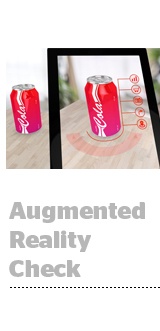
Augmented reality is more than just Pokémon – but it’s got a long way to go before it’s really mainstream.
“Pokemon GO created more awareness of augmented reality,” said Rachel Pasqua, North America practice lead of connected life at MEC Global. “But people in our little corner of the business have been aware of AR for years and years.”
Since the late ’90s, AR has mainly languished in the experimental budget bucket, if anywhere.
“It’s like VR right now, more talk than action, and that’s true for everyone, not just us,” Pasqua said.
That’s not to say clients aren’t interested. MEC works with a large cosmetics brand that’s looking into AR as a way to help customers sample its makeup, and it’s easy to think of use cases for jewelry, apparel or furniture brands – seeing how a bracelet or a sweater looks without actually having to try it on, or seeing how a sofa looks in someone’s living room before buying it.
But AR will remain a cool outlier or a one-off until the experience becomes part of something people do on a regular basis, said Matomy Group CTO Ido Pollak.
“Phones already have the computing power they need,” Pollak said. “Now we just need the applications.”
That’s the point when it stops “being a fun little toy and starts becoming mainstream,” said Brunno Attorre, co-founder of video monetization platform Uru.
Likely, that tipping point use case is not going to be game-related, but rather something like augmented search, content discovery, maps, navigation or conference calling – a “killer app” that anyone could use, Attorre said.
And until that happens, it’s premature to think about monetizing AR in any serious way.
“If it were integrated into something like Google Maps or Waze, there would be an everyday use case and plenty of reasons to use it again and again,” Pasqua said. “There needs to be enough content and variety of content and experiences in order to be perceived as more than just a one-off. Right now, most people experience AR through Pokémon GO or Snapchat.”
 But Snapchat and its filters are an increasingly pervasive – and frequently imitated (ahem, Facebook) – gateway into AR experiences, and Adaptly CEO and co-founder Nikhil Sethi predicts that Snapchat will continue to aggressively pursue augmented reality in the coming year.
But Snapchat and its filters are an increasingly pervasive – and frequently imitated (ahem, Facebook) – gateway into AR experiences, and Adaptly CEO and co-founder Nikhil Sethi predicts that Snapchat will continue to aggressively pursue augmented reality in the coming year.
“Soon, we may not need Snapcodes anymore, [and] users could just hold their phones up to someone’s face and find them on Snapchat,” Sethi said. “It’s easy to imagine a world where pointing a device at something allows users not only to identify that object, but also buy it.”
Augmented reality app Blippar is already doing something along those lines. The app, which has worked with advertisers like Coke, Unilever, Kraft, Time and Condé Nast, allows users to point their phones at objects in the real world, usually brand packaging, to unlock additional content.
In early December, Blippar released facial recognition software, powered by a database of about 70,000 public figures, that gives users the ability to scan people’s faces, either in person, in print or on TV, to find out more information about them.
In order to be blippable, regular folk have to set up a profile and scan their face.
The goal is to create what Blippar CEO Ambarish Mitra called “a knowledge graph of everything in the world.” To that end, it’s also possible to blipp non-proprietary things, like flowers to find out the type or dogs to learn the breed, which starts to fulfill the company’s vision of becoming a visual browser.
In the short term, however, Blippar isn’t looking for the brand application of the facial recognition feature beyond something that generates more organic usage on the app, and therefore more traffic to existing brand campaigns.
But Pasqua sees the potential – in the discovery functionality, rather than as a vehicle for ads.
“We are having some discussions about AR content in ads, but the real promise is as a search and information delivery tool,” she said.
And anyone who says they can do programmatic AR ads right now is pretty much blowing smoke, said Matomy’s Pollak.
“AR is definitely going to be huge, as is VR, but scale is an issue here,” he said. “For programmatic, you need scale, and until you can mass-produce AR content, that won’t happen.”
Regardless, AR is making a comeback thanks to Pokémon GO, which is great, Mitra said, but that’s not where the conversation around augmented reality should end.
“Pokémon GO is a game. It was never launched as a platform,” Mitra said. “We are an AR platform, and we’re fully committed to the AR route, and brands are investing in it with us.”
This post was syndicated from Ad Exchanger.

More Stories
Saturday, March 8 Evening Cable News Ratings: Have I Got News For You Continues to Lead the Demo for CNN
Sunday, March 9 Evening Cable News Ratings: The 2-Hour Big Weekend Show Is a Big No. 1 on Sundays
Monday, March 10 Evening Cable News Ratings: Gutfeld! Takes No. 1 in the Demo Over The Five